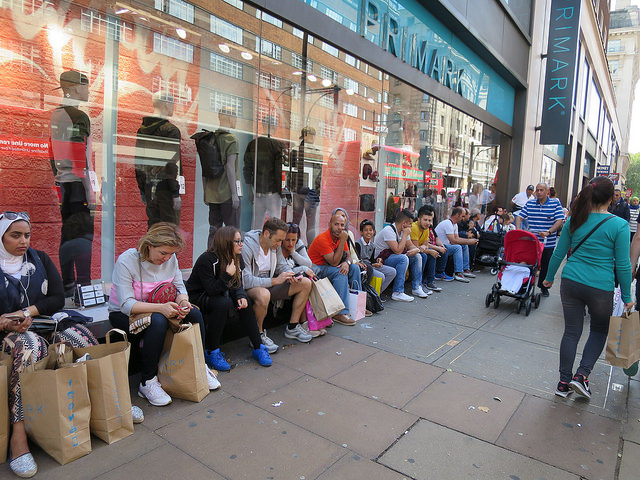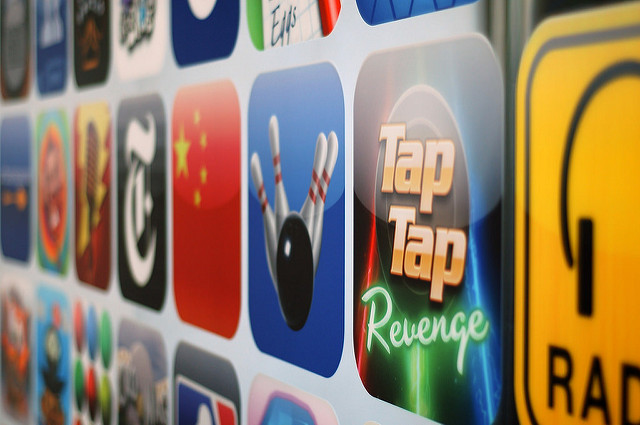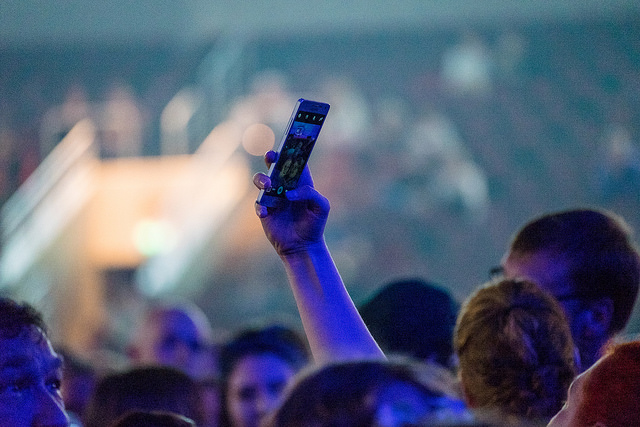With more than 2 billion people carrying smartphones now, it comes as no surprise that mobile marketing has become a hot topic. Businesses and mobile application development companies have over 4.2 million apps in the two major app stores right now. Mobile can be highly effective way increase brand awareness and drive customer engagement.
 Right now, mobile is a prime component of consumer behavior, but keep in mind that currently, a customer’s attention is a commodity that is in high demand. Smartphone users have a wealth of information available in the palm of their hand that they can access anytime day or night.
Right now, mobile is a prime component of consumer behavior, but keep in mind that currently, a customer’s attention is a commodity that is in high demand. Smartphone users have a wealth of information available in the palm of their hand that they can access anytime day or night.
For the past couple years, mobile has been ahead of desktop when it comes to internet usage and the gap is continuing to grow. Because of this, most businesses are looking for ways to leverage mobile to enhance their business.
Many companies have adopted a mobile-first approach, allowing them to integrate the benefits of mobile apps into their existing sales funnel in new and exciting ways. Most customers will now consult their mobile device at the early stages of shopping and will even check it while in physical stores. Consumers will read reviews and check product details, price and availability to confirm their choice or look for the best price.
The benefits of mobile
This shift from desktop to mobile use has created many exciting opportunities for businesses and marketers, allowing them to engage with consumers on whole new levels that 15 or 20 years ago they never would have even dreamed of. This is in part due to the technology incorporated into mobile devices such as GPS.
Beyond the hardware and tech features of the devices, the use of mobile device allows businesses to collect new types of data about the consumers they want to reach and utilize it to improve customer experiences.
Retail stores are in a prime position to be able to capitalize on these benefits. You can now deliver personalized messages and ads that are highly relevant to individual consumers at the time and place where they will do the most good.
Mobile allows businesses multiple possibilities of reaching consumers when they are on the go. If their campaigns are done correctly, relying on relevant data, they can deliver contextually relevant ads, offers, messages, etc. that can help them achieve new levels of engagement and success.
Why you need a mobile app
When it comes to mobile, consumers prefer mobile apps to mobile websites. In fact, according to comScore, mobile app usage is ahead of mobile web usage by a 7 to 1 margin. This indicates a very strong preference in the market that your business must account for in your mobile marketing plans.
From building your own app to allocating more resources to in-app advertising, when it comes to mobile, app related activities should be a primary focus. According to research on in-app ads, native ads are the most effective. Look for opportunities to utilize native ads since they are the less invasive to users and do not disrupt their user experience in the same way a display ad does.
And while mobile apps should be a primary focus, don’t forget about the mobile web. It has a substantial number of users and should not be forgotten. Keep in mind that the number of mobile searches on mobile surpassing desktop searches worldwide a year or so ago. You need to be prepared for users searching for your brand on the web.
Image: Alan Stanton (Flikr) http://bit.ly/2kQwrDW
Many entrepreneurs find that after they have gone through the mobile app development process with a mobile app development company that they are not getting the number of downloads that they expected. This is not surprising as building an app is just part of the journey.
 What you do after you have your app live is just as important as the time and money you put into having your app built. One essential part of your strategy after your app is live is to optimize your app store listings. This is more important than ever considering the number of apps that are now available on app stores.
What you do after you have your app live is just as important as the time and money you put into having your app built. One essential part of your strategy after your app is live is to optimize your app store listings. This is more important than ever considering the number of apps that are now available on app stores.
According to Apple, 65 percent of app downloads are a result of users searching the app store. This number is higher than any other method and makes optimizing your listing essential to app success. When you optimize your listing, your app will become more likely to appear in relevant searches. This allows you to better capitalize on the searches of users in the app stores.
To get maximum benefit, it is essential to consider the specific platform your app is available on as Apple and Google each have different methods for indexing apps. Because of this, you will want to create listings that cater to each platform individually.
Apple iTunes App Store
Optimizing your app listing here consists of two main parts: your app title and your app keywords. While your title will be the only one of these two visible to the public, both are important when it comes to how your app rank in searches.
Try combining words from your title and your keywords to create phrases that can generate more downloads. For example, if you have an app called ‘XYZ Chat App’ and you have the word ‘Free’ as one of your keywords since your app is free, you can help boost the number of times users find you by including the phrase ‘Free Chat App’ in your keywords since it is likely to be searched.
Apple will determine which phrases and keywords are most relevant based on your description and your app itself. Due to this, having the proper keywords in your title and keywords section is very important on the iTunes App Store.
Google Play
One big difference with Google Play is that it restricts the title to 30 characters. This will limit your ability to include key terms in your app’s title. Additionally, Google Play does not have a keyword section where you can enter manually targeted keywords.
Instead, Google Play will use your title, long description and short description to determine which terms are most relevant to your app. Your short description is an 80 character description of your app that appears to mobile users as they search. Google Play weighs your title and short description heavily when it determines your ranking, so make sure you use highly searched, relevant keywords and phrases in your short description.
This applies to your long description as well, if you can naturally work in highly searched, relevant keywords into your description in a natural way, you can improve your rankings.
Focus on Conversion
To improve the number of downloads you get, try to use the relevant, trending terms in your keywords. However, keywords should not be the only thing you consider. A user needs to look at your listing and decide to download your app.
Having the right icon and screenshots is very important. Fact is, if your app has great keywords, a solid title and a captivating description, but presents users with an unappealing icon and screenshots, you will not get the number of downloads you are hoping for.
On the iTunes App store, Apple will display two screenshots for each app in their search results. This makes your first two screenshots critical for converting. On the other hand, Google Play does not display screenshots in the search results. Your icon is the only image they feature. Making it very important in creating downloads.
Make sure you understand these differences when you set up your listing for each store. Remember that while each platform has its own unique set up, efforts made to optimize each according to their system will help improve the number of downloads you see for your app.
Pic: Cristiano Betta (Flikr) http://bit.ly/2iouEDW
Mobile technology is growing at lightning speed and mobile apps are a part of that ecosystem. This means the world is moving from desktop to mobile devices and it is apparent that every brand is making its presence felt via mobile apps. Basically, mobile apps are software applications designed to run on smartphones, tablets and wearables and are usually available through platforms known as app stores. Some businesses have in-house app development teams but most companies will contract with a mobile application development company to build their app for them.
 Today, with over 1.6 million apps available on Google Play and over 1.5 million on Apple’s App Store, the idea that mobile users have a wide variety of choices is an understatement.
Today, with over 1.6 million apps available on Google Play and over 1.5 million on Apple’s App Store, the idea that mobile users have a wide variety of choices is an understatement.
There are millions of apps to choose from, including social media apps, business apps, eCommerce apps, banking apps, gaming apps and business apps. But how many apps do people actually use? According to a new Nielsen report, smartphone owners use an average of 27.1 mobile apps per month.
Statistics about mobile app usage were gathered using Mobile NetView 3.0 data, which comes from mobile users who agreed to have tracking software installed on their devices. Approximately 9,000 panelists aged 18 and older participated in this study.
Despite rapid evolution throughout the marketplace, such as broadened device capabilities, additional device functionality and proliferation of new apps – the amount of time users are spending on those apps remained quite constant since the end of 2012, the study found.
However, since last quarter of 2012, the time spent per user every month has increased from 23 hours to nearly 41 hours.
The data collected by Nielsen was also broken down by gender and age. The study found overall, women spend slightly more time on apps than men do. They spend nearly three more hours each month using apps than their male counterparts do.
Another academic study conducted in South Korea also discovered that women spend more time on their smartphones. The report also stated that women tend to use social networks like Twitter, Facebook, Instagram, Whatsapp, etc. more than men.
Younger millennials also spend more time on apps.
Millennials are those born between 1981 and 1997 and are now at the adult age of 19-35 years. These are people who grew up in the computer age and also witnessed the rise of mobile phones. In fact, they are the main audience for mobile marketing. With that said, Nielsen noted that millennials aged 18-24 use less apps per month (about 25.5) than millennials aged 25-35. Older millennials use (about 28.2 applications). Though young millennials use fewer apps on a monthly basis, they invest more time making use of mobile apps compared to older millennials.
All said and done, if the growth trend of app usage is any pointer, the near future looks bright for businesses adapting to the mobile world, especially with smartphone and wearable shipments expected to increase by a huge percentage over the next few years.
Pic: Kārlis Dambrāns (Flikr) http://bit.ly/1Uz9FXd